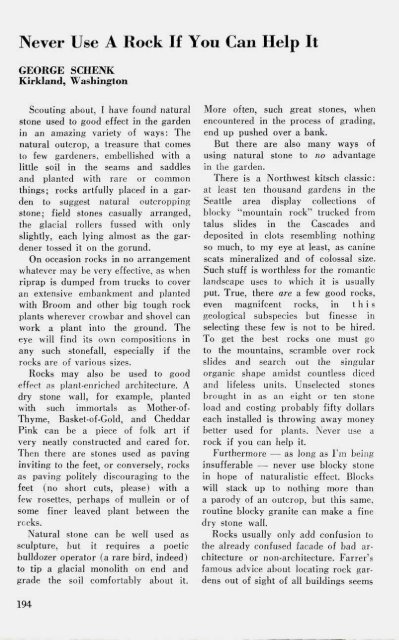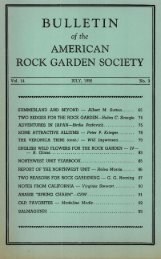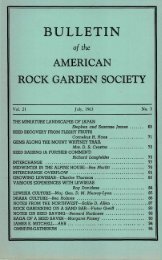Bulletin - Fall 1979 - North American Rock Garden Society
Bulletin - Fall 1979 - North American Rock Garden Society
Bulletin - Fall 1979 - North American Rock Garden Society
You also want an ePaper? Increase the reach of your titles
YUMPU automatically turns print PDFs into web optimized ePapers that Google loves.
Never Use A <strong>Rock</strong> If You Can Help ItGEORGE SCHENKKirkland, WashingtonScouting about, I have found naturalstone used to good effect in the gardenin an amazing variety of ways: Thenatural outcrop, a treasure that comesto few gardeners, embellished with alittle soil in the seams and saddlesand planted with rare or commonthings; rocks artfully placed in a gardento suggest natural outcroppingstone; field stones casually arranged,the glacial rollers fussed with onlyslightly, each lying almost as the gardenertossed it on the gorund.On occasion rocks in no arrangementwhatever may be very effective, as whenriprap is dumped from trucks to coveran extensive embankment and plantedwith Broom and other big tough rockplants wherever crowbar and shovel canwork a plant into the ground. Theeye will find its own compositions inany such stonefall, especially if therocks are of various sizes.<strong>Rock</strong>s may also be used to goodeffect as plant-enriched architecture. Adry stone wall, for example, plantedwith such immortals as Mother-of-Thyme, Basket-of-Gold, and CheddarPink can be a piece of folk art ifvery neatly constructed and cared for.Then there are stones used as pavinginviting to the feet, or conversely, rocksas paving politely discouraging to thefeet (no short cuts, please) with afew rosettes, perhaps of mullein or ofsome finer leaved plant between therecks.Natural stone can be well used assculpture, but it requires a poeticbulldozer operator (a rare bird, indeed)to tip a glacial monolith on end andgrade the soil comfortably about it.More often, such great stones, whenencountered in the process of grading,end up pushed over a bank.But there are also many ways ofusing natural stone to no advantagein the garden.There is a <strong>North</strong>west kitsch classic:at least ten thousand gardens in theSeattle area display collections ofblocky "mountain rock" trucked fromtalus slides in the Cascades anddeposited in clots resembling nothingso much, to my eye at least, as caninescats mineralized and of colossal size.Such stuff is worthless for the romanticlandscape uses to which it is usuallyput. True, there are a few good rocks,even magnifcent rocks, in thisgeological subspecies but finesse inselecting these few is not to be hired.To get the best rocks one must goto the mountains, scramble over rockslides and search out the singularorganic shape amidst countless dicedand lifeless units. Unselected stonesbrought in as an eight or ten stoneload and costing probably fifty dollarseach installed is throwing away moneybetter used for plants. Never use arock if you can help it.Furthermore — as long as I'm beinginsufferable — never use blocky stonein hope of naturalistic effect. Blockswill stack up to nothing more thana parody of an outcrop, but this same,routine blocky granite can make a finedry stone wall.<strong>Rock</strong>s usually only add confusion tothe already confused facade of bad architectureor non-architecture. Farrer'sfamous advice about locating rock gardensout of sight of all buildings seems194









